Battle Story (6 page)
Authors: Chris Brown

Infantry units throughout the British Empire and Commonwealth conformed to a common organisation. Each battalion had four rifle companies divided into four platoons and each platoon into three ‘sections’ of ten men. The standard firearm of all the Allied infantry, British, Indian and Australian, was the Lee-Enfield .303 calibre rifle. A reliable and accurate bolt-action weapon with a ten-round magazine, the Lee-Enfield was far superior to the Japanese Arisaka. In addition to the Lee-Enfields, each section had a Bren light machine gun. The Bren – like the Lee-Enfield – was a fine piece of equipment. The magazine could take thirty rounds, though it was common practice to load with only twenty-eight to reduce strain on the magazine spring and prevent jamming. Experience in France in 1940 had shown the need for another automatic weapon at section level. The Sten gun had been invented to fill this need along with large purchases of Thompson sub-machine guns from the United States, but many units in Malaya Command did not receive either in adequate quantities due to the demands of other theatres.
V
ICKERS
The Vickers gun was adopted by the British Army in 1912 and became the standard machine gun for all the Commonwealth countries. It was gas operated and the barrel was cooled by a water-filled jacket. Despite the tropical heat, the Vickers gun performed admirably in Malaya and Singapore. The gun fired the same .303 calibre bullets as the Lee-Enfield rifle and the Bren gun, but from 250-round canvas belts. Each battalion had a machine-gun platoon usually with four weapons and with six to eight men per gun; two to operate the weapon and the others to carry ammunition and provide protection for the gun team.
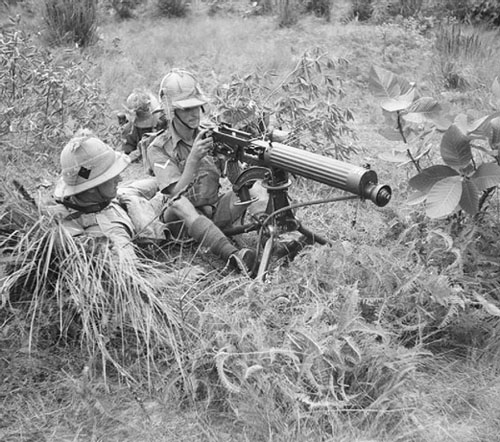
In theory, each infantry battalion also had a machine-gun platoon with Vickers .303in machine guns and a mortar platoon with 3in mortars. These were both good-quality weapons, but again the demands of other theatres had taken precedence and several battalions did not have their full complement. The battalion-level anti-tank weapon was the Boyes anti-tank rifle, a 0.5in bolt-action weapon, which was completely obsolete in Europe and North Africa against German and Italian vehicles, but could still make an impression on some of the lighter Japanese armoured cars and tanks.
One of the peculiarities of the British approach to combat was the Bren carrier. This lightly armoured tracked vehicle was put to innumerable uses, but its chief function was to provide rapid intervention and support for the rifle companies. Although a good deal of the tactical practice of an infantry battalion revolved around its carrier platoon, many units in Malaya Command did not have their full complement and some had none at all.
A great weakness in Malaya Command was communication. There was little wireless equipment and a good deal of what was available was not very effective. Laying cables for field telephones was slow and cumbersome and the cables themselves were very vulnerable to artillery fire.
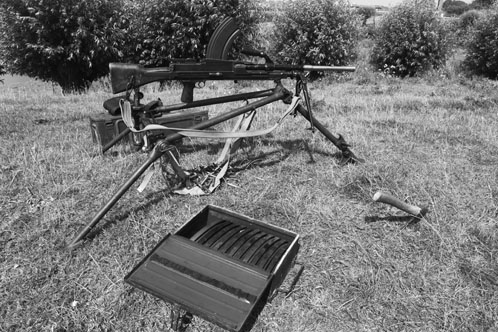
14. A Bren light machine gun on a tripod mount; a rare configuration. (Joost J. Bakker)
B
REN
C
ARRIERS
More Bren carriers were produced than any other armoured vehicle in history. Initially issued in small numbers to infantry battalions as transport for heavy equipment such as mortars, by late 1941 every battalion was supposed to have a ‘carrier platoon’ with 2in mortars and Bren guns to provide rapid support as required. Few of the infantry battalions in Malaya Command had their full complement of carriers and some none at all.
The artillery element of Malaya Command suffered from the same problems as the infantry. Most of the field artillery regiments had been issued with the excellent 25-pounder gun/howitzer, but because of the demands of the North Africa campaign several units had only two batteries of eight guns rather than three. The anti-tank regiments were, in the main, at full strength with forty-eight 2-pounder guns each. The 2-pounder was reasonably accurate and had a good rate of fire, but was relatively slow to deploy. Like the Boyes rifle, it had been made obsolete by the rapid development of armour in European armies, but it was capable of holding its own against Japanese tanks and armoured cars.
The most significant weakness on the ground lay in the complete absence of tanks. British tanks were not particularly well armoured or well armed, though many models were mechanically reliable. The various Vickers light tanks and the Matilda and Valentine models had proved to be entirely inadequate against the Axis forces in the desert, where a high degree of visibility often meant a British vehicle could be knocked out of action long before it was close enough to engage effectively, but these same vehicles
would have been on a par with their Japanese counterparts. The lack of tanks was not caused by demands elsewhere, but had been a matter of policy. Although General Bond had asked for at least one regiment of medium tanks as early as 1940, there was a near-universal assumption that tanks could not operate in the terrain of Malaya.
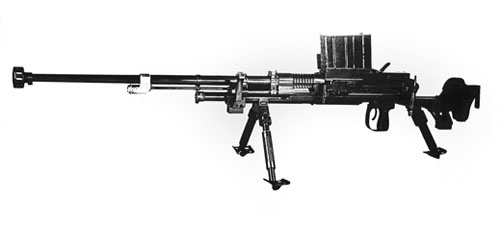
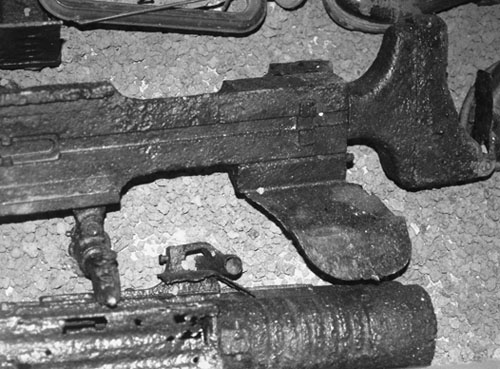
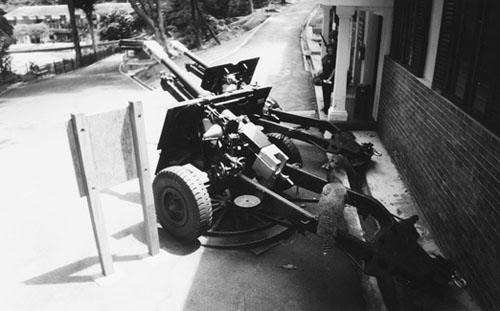
17. 25-pounder field guns at Sentosa, Singapore. (Author’s collection)
25-P
OUNDER
G
UN
The 25-pounder was the standard field artillery piece of the Royal Artillery and with Commonwealth armies throughout the Second World War; it remained in service until the 1960s and well beyond in other countries. Each field regiment was equipped with twenty-four guns divided into three batteries of eight, each comprising two troops of four and they in turn consisted of two sections of two guns each. Strictly speaking, the 25-pounder was a ‘gun/howitzer’ since it could fire in both the lower register (0–45 degrees) and the upper register (45–90 degrees). The gun provided sterling service in Malaya despite the hot and damp conditions, though several regiments had only two batteries instead of three.
2-
POUNDER
AT G
UN
The 2-pounder was the standard British and Commonwealth anti-tank gun at the beginning of the Second World War. Although it was originally designed to be mounted in tank turrets, the army sought a surface mounting so that it could be used by anti-tank regiments or anti-tank platoons in infantry battalions. The carriage adopted had three legs, two of which folded up under the gun whilst in transport. Those two legs and the wheels had to be moved to position the gun for action, which made it difficult to deploy quickly, but once it was ready the gun could traverse easily through 360 degrees. By late 1941 the 2-pounder had been outclassed by German and Italian tanks but it was quite capable of penetrating the relatively thin and poor-quality hulls of the Japanese Chi-Ha and Ha-Go.
There was a modest supply of armoured cars, mostly Marmon- Herringtons and Lanchesters, but these were slow and lightly armoured. None of them mounted anything heavier than a machine gun and were therefore clearly incapable of standing up to Japanese tanks. The problems were multiplied by an almost total deficiency in training. The Indian 3rd Cavalry had their horses replaced with armoured cars but had had virtually no training at all, with the result that almost all of their vehicles were written off before they could go into action. In addition, because of the assumption that Malaya was not suitable territory for armoured conflict, none of the infantry units had had any worthwhile training in dealing with armoured attacks; many soldiers had never even seen a tank before they encountered them on the battlefield.
The assumptions about the ‘impenetrable jungle’ and the impracticality of armoured warfare were simply ridiculous and should have been challenged by the senior officers in Malaya Command. Armies in general – and tanks in particular – travel along roads primarily, only deploying to countryside when obstructed by the enemy, and although there were few roads running east–west across the country, there were fine highways running south from Thailand to Singapore. Tactical assumptions made once the campaign started were often just as bad. Wavell’s instructions to Percival that he should fight the ‘main battle’ in areas where his ‘superior artillery’ could be used to advantage were not superficially unreasonable, but rather depended on the belief that the Japanese artillery was not capable of effective counter-battery work. In practice, poor communications, poor training, a failure to ensure adequate supplies of ammunition and the inability to stem Japanese advance undermined the premise. After the lengthy retreat down the peninsula, the troops were not confident in combat and became increasingly unlikely to make a determined stand. Often, when they did stop the Japanese advance, they were obliged to retire because of threats to their flanks or breakthroughs against other units that might result in encirclement. A number of withdrawals occurred due to misleading orders or to the perceived need to maintain the integrity of formations as viable combat assets.